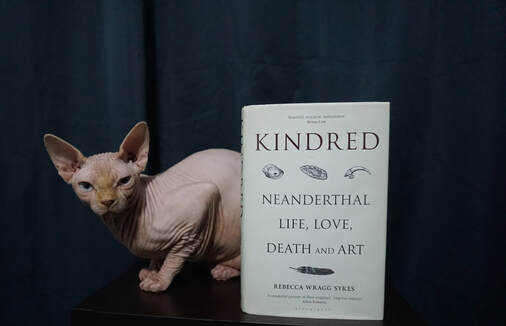|
Wilbur also enjoyed this book. I could tell because he wouldn't stop rubbing his cheek on it as I read. Photo by Kate Ota 2020 Kindred by Rebecca Wragg Sykes is a non-fiction book covering everything we know (as of June 2020) about our extinct relatives, Homo neanderthalensis, aka Neanderthals. It covers the gambit, from their appearance to their disappearance in the fossil record, their births to some of their deaths, and their rediscovery in the 1800s. And yes, it was a rediscovery, because, as many of you know, Homo sapeins (aka modern humans) interacted with Neanderthals many-thousands of years ago and now a good percentage of us contain Neanderthal DNA.
This book also discussed what we’ve been able to discover about their lives. Different types of stone tools, pigments, possible jewelry or other ornamentation, and even possible art or math. Of course, so much hasn’t yet been discovered. One of my favorite mysteries is the disparity between the number of found male and female remains (where the ladies at?) I read this book as research for my WIP and it was exactly what I needed. It compares and contrasts Neanderthal and modern human bodies and, as much as it can, development and daily life. I highlighted so much of it! Honestly, this book made me want to go dig around and find some ancient bones to study myself. (As a kid, I wanted to be a Paleontologist until I learned they camp near the dig site a lot. I’m not outdoorsy.) Positives: The book was extremely thorough, which is what I wanted. It also had some amazing footnotes. My personal favorite was about an old timey duel where the weapon of choice was sausages. (If only Alexander Hamilton had thought of that!) I also liked how it was organized, moving from appearance/early Neanderthal life to extinction/individual deaths, having the life of the species be discussed along side the life of individuals. On the inside cover, there's a map of where all the discoveries referenced were made, which I loved. I'm a sucker for maps. Negatives: I didn’t have any complaints, but I should warn potential readers that others did. Some reviews complained about technical language. I didn’t think it was too jargon-y, but depending on your background, you may end up doing some light googling. Each chapter opens with a literary style section, often imagining the world from Neanderthal perspectives, which I didn’t mind. Some reviewers whined about this. If they're not your cup of tea, you can skip them. Overall rating: 5/5 This is exactly the book I needed, exactly when I needed it! I’d recommend this to fans of science non-fiction, anyone with an interest in ancient hominins (especially, obviously, Neanderthals), and anyone with an interest in the history of science (particularly the Victorian era, as it covers events from that time with specificity and later discoveries in more general terms.) Not for people who don’t like non-fiction, or those who seek short chapters or short books (hardback was 385 pages). Side note: The author also co-founded the TrowelBlazers project and the website is bursting with really awesome archaeologists/earth scientists who happen to be women. If you love women in STEM stuff, check it out! Have your read Kindred or any other science non-fiction recently? Let's discuss in the comments!
1 Comment
|
Archives
April 2024
Categories
All
|


 RSS Feed
RSS Feed